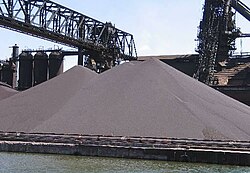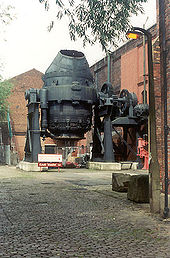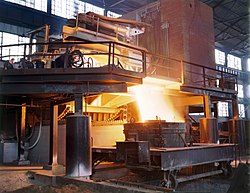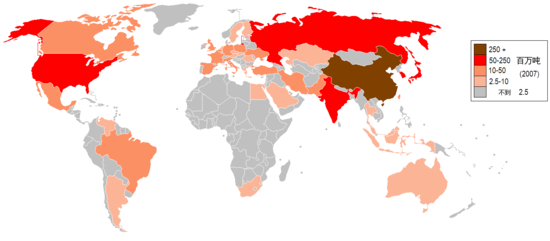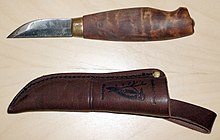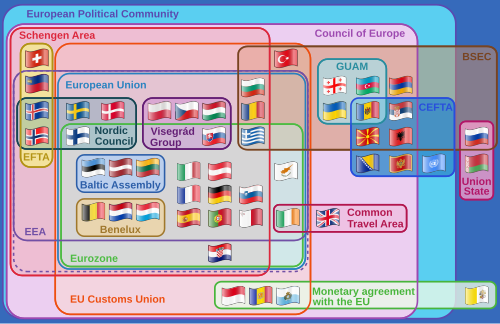From Wikipedia, the free encyclopedia
The space program of the People's Republic of China is directed by the China National Space Administration (CNSA). Its technological roots can be traced back to the late 1950s, when the People's Republic began a rudimentary ballistic missile program in response to perceived American (and, later, Soviet) threats. However, the first Chinese crewed space program only began several decades later, when an accelerated program of technological development culminated in Yang Liwei's successful 2003 flight aboard Shenzhou 5. This achievement made China the third country to independently send humans into space. Plans currently include a permanent Chinese space station in 2020 and crewed expeditions to the Moon and Mars.
History and recent developments
During the period of Sino-Soviet co-operation
After the United States threatened to use nuclear weapons during the Korean War, Chairman Mao Zedong decided that only a nuclear deterrent of its own would guarantee the security of the newly founded PRC. Additionally, he wanted China to gain status among the world's powers that—as he felt—did not respect him. From this, he decided instead to only implement his new plan with the Republic of China (present-day Taiwan) as "China". Thus, Mao announced his decision to develop China's own strategic weapons, including nuclear bombs and associated missiles for the warheads, during a Communist Party of China (CPC) Central Committee meeting held on January 15, 1955. The Chinese nuclear weapons program was designated by the codename of "02".| “ | 我们不但要有更多的飞机大炮,而且还要有原子弹。 在今天这个世界上,我们要不受人家欺侮,就不能没有这个东西。 Not only do we need more airplanes and artillery pieces, we also need the atomic bomb. In this world today, to avoid being bullied, we cannot be without it. |
” |
The Fifth Academy of the National Defense Ministry (国防部第五研究院) was founded on October 8, 1956, with Qian Xuesen, who had just been deported from the United States after being accused of being a communist during the red scare, as director. The Academy started the development of the first ballistic missile program, adopted on March 1, 1956 and known as the first Twelve-Year-Plan for Chinese aerospace.[1]
After the launch of mankind's first artificial satellite, Sputnik 1, by the Soviet Union on October 4, 1957, Mao decided during the National Congress of the CPC on May 17, 1958 to make China an equal with the superpowers (“我们也要搞人造卫星”)(We need the artificial too), by adopting Project 581 with the objective of placing a satellite in orbit by 1959 to celebrate the 10th anniversary of the PRC's founding.[2] This goal would be achieved in three phases: developing sounding rockets first, then launching small satellites and in the final phase, large satellites.
- The construction of China's first missile test base, code-named Base 20 (西北综合导弹试验基地), started in April 1958 and it entered service on October 20 of the same year.
- The first Chinese missile was built in October 1958 as a reverse-engineered copy of the Soviet R-2 short-range ballistic missile (SRBM), itself an upgraded version of a German V-2 rocket. Its range was 590 km, weighing 20.5 tons and propelled with liquid oxygen and alcohol.
- China's first ever T-7 sounding rocket was successfully launched from the Nanhui launch site on February 19, 1960.[3]
- China started to develop medium-range ballistic missiles (MRBM) in July 1960, with an increased range double that of the R-2.
Missile and Space development after the Sino-Soviet split
Only 17 days after the last Soviet expert had left China, the first Soviet built R-2 rocket fueled with Chinese-made propellant was launched with success on September 10, 1960. Due to Cold War tension, Mao decided in December 1963 that China should develop missile defence system capacity. During a conference held on February 2, 1964, directive 640(640指示)was adopted (later known as Project 640).[4]- The first successful launch of a Chinese 1059 SRBM missile copy of the R-2 was conducted only two months later on November 5, 1960. The missile was also designated DF-1. The first DF-2 MRBM was tested on March 21, 1962, but failed.
- Development eventually continued with the redesigned DF-2A MRBM which was successfully tested on June 29, 1964. It would enter service by the end of 1966.
- The first successful launch and recovery of a T-7A(S1) sounding rocket carrying a biological experiment (transporting eight white mice) was on July 19, 1964 from Base 603(安徽广德誓节渡中国科学院六〇三基地.[5]
- China started to develop the DF-5 intercontinental ballistic missile (ICBM) program in August 1965. It was designed to carry a single nuclear warhead and has a maximum range of 12000 km. In November 1966, it was decided to build a second ballistic missile test site, the Northern Missile Test Site (华北导弹试验场)) in Shanxi Province, farther away from China's northern border.
- On October 27, 1966, a nuclear-tipped DF-2A missile was launched from Jiuquan and the 20 kilotons yield nuclear warhead exploded at the height of 569 meters over the target in Lop Nor or Base 21 situated 894 km away.
- On December 26, 1966, China tested its first indigenously developed DF-3 intermediate-range ballistic missile (IRBM) with success. The DF-3 was a single-stage, single-warhead missile with a maximum range of 2500 km. The development of the DF-4 IRBM began in 1967 in parallel with the single-stage DF-3.
- In March 1967, development started on the JL-1 submarine-launched ballistic missile to accompany the Type 092 ballistic missile submarine (SSBN) also in development.
- China's first spacecraft designed for human occupancy was named Shuguang-1 (曙光一号) in January 1968.[7] China's Space Medical Institute (航天医学工程研究所) was founded on April 1, 1968, and the Central Military Commission issued the order to start the selection of astronauts.
- As part of the "third line" effort to relocate critical defense infrastructure to the relatively remote interior (away from the Soviet border), it was decided to construct a new space center in the mountainous region of Xichang in the Sichuan province, code-named Base 27.
- A first liquid-propellant DF-3 medium-range ballistic missile was successfully launched from the Northern Missile Test Site on December 18, 1968, inaugurating the test site.
- In August 1969, the development of China's first heavy-lift satellite launch vehicle (SLV), the FB-1 (风暴一号, was started by Shanghai’s 2nd Bureau of Mechanic-Electrical Industry. The all-liquid two-stage launcher was derived from the DF-5 ICBM. Only a few months later, a parallel heavy-lift SLV program, also based on the same DF-5 ICBM and known as CZ-2, was started in Beijing by the First Space Academy.
- The DF-4 was used to develop the Long March-1 SLV. A newly designed spin-up orbital insertion solid propellant rocket motor third stage was added to the two existing Nitric acid/UDMH liquid propellant stages. An attempt to use this vehicle to launch a Chinese satellite before Japan's first attempt ended in failure on November 16, 1969.[8]
- The first DF-4 liquid-propellant with two-stage, single-warhead IRBM was tested with success on January 30, 1970. The addition of a second-stage allowed the missile to increased its range to over 4750 km.
- The second satellite launch attempt on April 24, 1970 was successful. A CZ-1 was used to launch the 173 kg Dong Fang Hong I (东方红一号, meaning The East Is Red I), also known as Mao-1. It was the heaviest first satellite placed into orbit by a nation, exceeding the combined masses of the first satellites of the other four previous countries. The third stage of the CZ-1 was specially equipped with a 40 m2 solar reflector (观察球) deployed by the centrifugal force developed by the spin up orbital insertion solid propellant stage. Therefore, the faint magnitude 5 to 8 brightness of the DFH-1 made the satellite (at best) barely visible with naked eyes was consequently dramatically increased to a comfortable magnitude 2 to 3.
- The PRC's second satellite was launched with the last of the CZ-1 SLVs on March 3, 1971. The 221 kg ShiJian-1 (SJ-1) was equipped with a magnetometer and cosmic-ray/x-ray detectors.
- The first crewed space program known as Project 714, was officially adopted in April 1971 with the goal of sending two astronauts into space by 1973 aboard the Shuguang spacecraft. The first screening process for astronauts had already ended on March 15, 1971, with 19 astronauts chosen. The program would soon be cancelled due to political turmoil.
- A first flight test of the DF-5 ICBM was carried out in October 1971.
- On August 10, 1972, the new heavy-lift SLV FB-1 made its maiden test flight, with only partial success.[clarification needed]
- The CZ-2A launcher, originally designed to carry the Shuguang-1 spacecraft, was first tested on November 5, 1974, carrying China’s first FSW-0 recoverable satellite, but failed. After some redesign work, the modified CZ-2C successfully launched the FSW-0 No.1 recoverable satellite (返回式卫星) into orbit on November 26, 1975.
- After expansion, the Northern Missile Test Site was upgraded as a test base in January 1976 to become the Northern Missile Test Base (华北导弹试验基地) known as Base 25.
After Mao Zedong's death
After Mao died on September 9, 1976, his rival, Deng Xiaoping, denounced during the Cultural Revolution as reactionary and therefore forced to retire from all his offices, slowly re-emerged as China's new leader in 1978. At first, new development was slowed. Then, several key projects deemed unnecessary were simply cancelled—the Fanji ABM system, the Xianfeng Anti-Missile Super Gun, the ICBM Early Warning Network 7010 Tracking Radar and the land-based high-power anti-missile laser program. Nevertheless, some development did proceed.- The first Yuanwang-class space tracking ship was commissioned in 1979.
- The first full-range test of the DF-5 ICBM was conducted on May 18, 1980. The payload reached its target located 9300 km away in the South Pacific (7°0′S 117°33′E / 7.000°S 117.550°E) and retrieved five minutes later by helicopter.
- Further development of the Long March rocket series allowed the PRC to initiate a commercial launch program in 1985, which has since launched over 30 foreign satellites, primarily for European and Asian interests.
- The next crewed space program was even more ambitious and proposed in March 1986, as Astronautics plan 863-2. This consisted of a crewed spacecraft (Project 863-204) used to ferry astronaut crews to a space station (Project 863-205). Several spaceplane designs were rejected two years later and a simpler space capsule was chosen instead. Although the project did not achieve its goals, it would ultimately evolve into the 1992 Project 921.
- The China Ministry of Aerospace Industry was founded on July 5, 1988.
- On September 15, 1988, a JL-1 SLBM was launched from a Type 092 submarine. The maximum range of the SLBM is 2150 km.
After the end of the Cold War
Along with Deng's policy of de facto restoration of capitalism in the Chinese economy, implemented in incremental steps, the cultural fabric of the Chinese society was soon his next target. Therefore, names used in the space program, previously all chosen from the revolutionary history of the PRC, were soon replaced with mystical-religious ones. Thus, new Long March carrier rockets were renamed Divine arrow (神箭),[9][10] spacecraft Divine vessel (神舟),[11] space plane Divine dragon (神龙),[12] land-based high-power laser Divine light (神光)[13] and supercomputer Divine might (神威).[14]- In June 1993, China Aerospace Industry Corporation (National Space Bureau) was founded in Beijing.
- On February 15, 1996, during the flight of the first Long March 3B heavy carrier rocket carrying Intelsat 708, the rocket veered off course immediately after clearing the launch platform, crashing 22 seconds later. It crashed 1.85 km (1.15 mi) away from the launch pad into a nearby mountain village. According to the official count, it destroyed 80 houses. More than 500 civilians died as a result, according to unofficial Chinese sources.[15]
- On the 50th anniversary of the PRC's founding, China launched the Shenzhou 1 spacecraft on November 20, 1999 and recovered it after a flight of 21 hours. The country became the third country with a successful crewed space program by sending an astronaut into space aboard Shenzhou 5 on October 15, 2003 for more than 21 hours.
Chinese space program and the International Community
Dual-use technologies and outer space
The PRC is a member of the United Nations Committee on the Peaceful Uses of Outer Space and a signatory to all United Nations treaties and conventions on space.[citation needed] The United States government has long been resistant to the use of PRC launch services by American industry due to concerns over alleged civilian technology transfer that could have dual-use military applications to countries such as North Korea, Iran or Syria, and announced an official embargo against the PRC in 2000.[citation needed] Thus, financial retaliatory measures have been taken on many occasions against several Chinese space companies.[16]Chinese exclusion policy of NASA
Due to security concerns, all researchers from the U.S. National Aeronautics and Space Administration (NASA) are prohibited from working with Chinese citizens affiliated with a Chinese state enterprise or entity.[17] In April 2011, the 112th United States Congress banned NASA from using its funds to host Chinese visitors at NASA facilities.[18] In March 2013, the U.S. Congress passed legislation barring Chinese nationals from entering NASA facilities without a waiver from NASA.[17]Organization
Initially the space program of the PRC was organized under the People's Liberation Army, particularly the Second Artillery Corps. In the 1990s, however, the PRC reorganized the space program as part of a general reorganization of the defense industry to make it resemble Western defense procurement.The China National Space Administration, an agency within the Commission of Science, Technology and Industry for National Defense currently headed by Sun Laiyan, is now responsible for launches. The Long March rocket is produced by the China Academy of Launch Vehicle Technology, and satellites are produced by the China Aerospace Science and Technology Corporation. The latter organizations are state-owned enterprises; however, it is the intent of the PRC government that they should not be actively state managed and that they should behave much as private companies would in the West.
Universities and institutes
The space program also has close links with:- School of Astronautics, Beijing University of Aeronautics and Astronautics (BUAA), Beihang University
- School of Aerospace, Tsinghua University
- School of Aerospace, Xi'an Jiaotong University
- School of Aeronautics and Astronautics, Zhejiang University
- Institute of Aerospace Science and Technology, Shanghai Jiaotong University
- College of Aeronautics, Harbin Institute of Technology
- School of Automation Science and Electrical Engineering, Beihang University
Space cities
- Dongfeng space city (东风航天城),also known as Base 20 (二十基地) or Dongfeng base (东风基地)[19]
- Beijing space city (北京航天城)
- Wenchang space city (文昌航天城)
- Shanghai space city (上海航天城)
- Yantai space city (烟台航天城)[20][21]
- Guizhou Aerospace Industrial Park (贵州航天高新技术产业园),also known as Base 061 (航天○六一基地), founded in 2002 after approval of Project 863 for industrialization of aerospace research centers (“国家863计划成果产业化基地”).[22]
Suborbital launch sites
- Nanhui (南汇县老港镇东进村) First successful launch of a T-7M sounding rocket on February 19, 1960.[3]
- Base 603 (安徽广德誓节渡中国科学院六○三基地) Also known as Guangde Launch Site (广德发射场).[23] The first successful flight of a biological experimental T-7A(S1) sounding rocket transporting eight white mice was launched and recovered on July 19, 1964.[24]
Satellite launch centers
The PRC operates 4 satellite launch centers:- Jiuquan Satellite Launch Center (JSLC)
- Xichang Satellite Launch Center (XSLC)
- Taiyuan Satellite Launch Center (TSLC)
- Wenchang Satellite Launch Center (WSLC)
Monitoring and control centers
- Beijing Aerospace Command and Control Center (BACCC)
- Xian Satellite Monitor and Control Center (XSCC) also known as Base 26(二十六基地)
- Fleet of six Yuanwang-class space tracking ships.[25]
- Data relay satellite (数据中继卫星) Tianlian I (天链一号), specially developed to decrease the communication time between the Shenzhou 7 spaceship and the ground; it will also improve the amount of data that can be transferred. The current orbit coverage of 12 percent will thus be increased to a total of about 60 percent.[26][27]
- Deep Space Tracking Network composed with radio antennas in Beijing, Shanghai, Kunming and Urumuqi, forming a 3000 km VLBI(甚长基线干涉).[28]
Domestic tracking stations
- New integrated land-based space monitoring and control network stations, forming a large triangle with Kashi in the north-west of China, Jiamusi in the north-east and Sanya in the south.[29]
- Weinan Station
- Changchun Station
- Qingdao Station
- Zhanyi Station
- Nanhai Station
- Tianshan Station
- Xiamen Station
- Lushan Station
- Jiamusi Station
- Dongfeng Station
- Hetian Station
Overseas tracking stations
- Karachi Station
- Tarawa Station, Kiribati (dismantled in 2003[30])
- Malindi Station
- Swakopmund tracking station in Namibia
Crewed spacecraft landing site
Crewed spaceflight programs
Project 714
As the Space Race between the two superpowers reached its climax with the conquest of the Moon, Mao Zedong and Zhou Enlai decided on July 14, 1967 that the PRC should not be left behind, and therefore initiated China's own crewed space program. The top-secret Project 714 aimed to put two people into space by 1973 with the Shuguang spacecraft. Nineteen PLAAF pilots were selected for this goal on March 1971. The Shuguang-1 spacecraft to be launched with the CZ-2A rocket was designed to carry a crew of two. The program was officially cancelled on May 13, 1972 for economic reasons, though the internal politics of the Cultural Revolution likely motivated the closure.The short-lived second crewed program was based on the successful implementation of landing technology (third in the World after USSR and USA) by FSW satellites. It was announced few times in 1978 with the open publishing of some details including photos, but then was abruptly canceled in 1980. It has been argued that the second crewed program was created solely for propaganda purposes, and was never intended to produce results.[31]
Project 863
A new crewed space program was proposed by the Chinese Academy of Sciences in March 1986, as Astronautics plan 863-2. This consisted of a crewed spacecraft (Project 863-204) used to ferry astronaut crews to a space station (Project 863-205). In September of that year, astronauts in training were presented by the Chinese media. The various proposed crewed spacecraft were mostly spaceplanes. Project 863 ultimately evolved into the 1992 Project 921.Project 921
Spacecraft
In 1992, authorization and funding was given for the first phase of Project 921, which was a plan to launch a crewed spacecraft. The Shenzhou program had four uncrewed test flights and two crewed missions. The first one was Shenzhou 1 on November 20, 1999. On January 9, 2001 Shenzhou 2 launched carrying test animals. Shenzhou 3 and Shenzhou 4 were launched in 2002, carrying test dummies. Following these was the successful Shenzhou 5, China's first crewed mission in space on October 15, 2003, which carried Yang Liwei in orbit for 21 hours and made China the third nation to launch a human into orbit. Shenzhou 6 followed two years later ending the first phase of the Project 921. Missions are launched on the Long March 2F rocket from the Jiuquan Satellite Launch Center.
The China Crewed Space Engineering Office provides engineering and administrative support for the crewed Shenzhou missions.[32]
On October 31, 2011, a Long March 2F rocket lifted the Shenzhou 8 uncrewed spacecraft which docked twice with the Tiangong 1 module. The Shenzhou 9 craft took off on 16 June 2012 with a crew of 3. It successfully docked with the Tiangong-1 laboratory on 18 June 2012, at 06:07 UTC, marking China's first manned spacecraft docking.[33] Another manned mission, Shenzhou 10, launched on 11 June 2013 . The Tiangong 1 target module is then expected to be deorbited.[34]
A second space lab, Tiangong 2, is scheduled for launch in 2016.[35] This will be larger than Tiangong 1 at some 20 tons and 14.4 metres length and will be visited by future Shenzhou missions, though exact details are not yet available.
A larger basic permanent space station (基本型空间站) would be the third and last phase of Project 921. This will be a modular design with an eventual weight of around 60 tons, to be completed sometime before 2020. The first section, designated Tiangong 3, is scheduled for launch after Tiangong 2.[36] Tiangong 3 will weigh 22 tons and be 18.1 metres long. Additional modules will be connected over several missions to build the space station.
This could also be the beginning of China's crewed international cooperation, the existence of which was officially disclosed for the first time after the launch of Shenzhou 7.[37]
The Chinese space station is scheduled to be completed in 2020, just as the International Space Station is scheduled to retire.[38]
On November 27, 2005, the deputy commander of the crewed spaceflight program announced that the PRC planned to complete a space station and a crewed mission to the Moon by 2020, assuming funding was approved by the government.
On December 14, 2005, it was reported "an effort to launch lunar orbiting satellites will be supplanted in 2007 by a program aimed at accomplishing an uncrewed lunar landing. A program to return uncrewed space vehicles from the moon will begin in 2012 and last for five years, until the crewed program gets underway" in 2017, with a crewed Moon landing some time after that.[39]
Nonetheless, the decision to develop a totally new moon rocket in the 1962 Soviet UR-700M-class (Project Aelita) able to launch a 500 ton payload in LTO[dubious ] and a more modest 50 tons LTO payload LV has been discussed in a 2006 conference by academician Zhang Guitian (张贵田), a liquid propellant rocket engine specialist, who developed the CZ-2 and CZ-4A rockets engines.[40][41][42]
On June 22, 2006, Long Lehao, deputy chief architect of the lunar probe project, laid out a schedule for China's lunar exploration. He set 2024 as the date of China's first moonwalk.[43]
In September 2010, it was announced that the country is planning to carry out explorations in deep space by sending a man to the Moon by 2025. China also hopes to bring a moon rock sample back to Earth in 2017, and subsequently build an observatory on the Moon's surface. Ye Peijian, Commander in Chief of the Chang’e programme and an academic at the Chinese Academy of Sciences, added that China has the "full capacity to accomplish Mars exploration by 2013."[44][45]
On December 14, 2013 [46] China's Chang'e 3 became the first object to soft-land on the Moon since Luna 24 in 1976.[47]
As indicated by the official Chinese Lunar Exploration Program insignia, denoted by a calligraphic Moon ideogram (月) in the shape of a nascent lunar crescent, with two human footsteps at its center, the ultimate objective of the program is to establish a permanent human presence on the Earth's natural satellite.
Yang Liwei declared at the 16th Human in Space Symposium of International Academy of Astronautics (IAA) in Beijing, on May 22, 2007 that building a lunar base was a crucial step to realize a flight to Mars and farther planets.[48]
According to practice, since the whole project is only at a very early preparatory research phase, no official crewed Moon program has been announced yet by the authorities. But its existence is nonetheless revealed by regular intentional leaks in the media.[49] A typical example is the Lunar Roving Vehicle (月球车) that was shown on a Chinese TV channel (东方卫视) during the 2008 May Day celebrations.
The first uncrewed Mars exploration program could take place between 2015–2033, followed by a crewed phase in 2040-2060.[51] The Mars 500 study of 2011 prepared for this manned mission.
Moreover, in order to make crewed flight in deep space toward Mars safer, a space weather forecast system will be completed by 2017 with the Kuafu[52] mission satellites placed at the Lagrangian Point L1.[53]
The Chief designer of the Shenzhou spacecraft has stated in 2006 in an interview that:
Space laboratory
The second phase of the Project 921 started with Shenzhou 7, China's first spacewalk mission. Then, two crewed missions were planned to the first Chinese space laboratory. The PRC initially designed the Shenzhou spacecraft with docking technologies imported from Russia, therefore compatible with the International Space Station (ISS). On September 29, 2011, China launched Tiangong 1. This target module is intended to be the first step to testing the technology required for a planned space station.On October 31, 2011, a Long March 2F rocket lifted the Shenzhou 8 uncrewed spacecraft which docked twice with the Tiangong 1 module. The Shenzhou 9 craft took off on 16 June 2012 with a crew of 3. It successfully docked with the Tiangong-1 laboratory on 18 June 2012, at 06:07 UTC, marking China's first manned spacecraft docking.[33] Another manned mission, Shenzhou 10, launched on 11 June 2013 . The Tiangong 1 target module is then expected to be deorbited.[34]
A second space lab, Tiangong 2, is scheduled for launch in 2016.[35] This will be larger than Tiangong 1 at some 20 tons and 14.4 metres length and will be visited by future Shenzhou missions, though exact details are not yet available.
Space station
This could also be the beginning of China's crewed international cooperation, the existence of which was officially disclosed for the first time after the launch of Shenzhou 7.[37]
The Chinese space station is scheduled to be completed in 2020, just as the International Space Station is scheduled to retire.[38]
Proposed lunar exploration
In February 2004, the PRC formally started the implementation phase of its uncrewed Moon exploration project. According to Sun Laiyan, administrator of the China National Space Administration, the project will involve three phases: orbiting the Moon; landing; and returning samples. The first phase planned to spend 1.4 billion renminbi (approx. US$170 million) to orbit a satellite around the Moon before 2007, which is ongoing. Phase two involves sending a lander before 2010. Phase three involves collecting lunar soil samples before 2020.On November 27, 2005, the deputy commander of the crewed spaceflight program announced that the PRC planned to complete a space station and a crewed mission to the Moon by 2020, assuming funding was approved by the government.
On December 14, 2005, it was reported "an effort to launch lunar orbiting satellites will be supplanted in 2007 by a program aimed at accomplishing an uncrewed lunar landing. A program to return uncrewed space vehicles from the moon will begin in 2012 and last for five years, until the crewed program gets underway" in 2017, with a crewed Moon landing some time after that.[39]
Nonetheless, the decision to develop a totally new moon rocket in the 1962 Soviet UR-700M-class (Project Aelita) able to launch a 500 ton payload in LTO[dubious ] and a more modest 50 tons LTO payload LV has been discussed in a 2006 conference by academician Zhang Guitian (张贵田), a liquid propellant rocket engine specialist, who developed the CZ-2 and CZ-4A rockets engines.[40][41][42]
On June 22, 2006, Long Lehao, deputy chief architect of the lunar probe project, laid out a schedule for China's lunar exploration. He set 2024 as the date of China's first moonwalk.[43]
In September 2010, it was announced that the country is planning to carry out explorations in deep space by sending a man to the Moon by 2025. China also hopes to bring a moon rock sample back to Earth in 2017, and subsequently build an observatory on the Moon's surface. Ye Peijian, Commander in Chief of the Chang’e programme and an academic at the Chinese Academy of Sciences, added that China has the "full capacity to accomplish Mars exploration by 2013."[44][45]
On December 14, 2013 [46] China's Chang'e 3 became the first object to soft-land on the Moon since Luna 24 in 1976.[47]
As indicated by the official Chinese Lunar Exploration Program insignia, denoted by a calligraphic Moon ideogram (月) in the shape of a nascent lunar crescent, with two human footsteps at its center, the ultimate objective of the program is to establish a permanent human presence on the Earth's natural satellite.
Yang Liwei declared at the 16th Human in Space Symposium of International Academy of Astronautics (IAA) in Beijing, on May 22, 2007 that building a lunar base was a crucial step to realize a flight to Mars and farther planets.[48]
According to practice, since the whole project is only at a very early preparatory research phase, no official crewed Moon program has been announced yet by the authorities. But its existence is nonetheless revealed by regular intentional leaks in the media.[49] A typical example is the Lunar Roving Vehicle (月球车) that was shown on a Chinese TV channel (东方卫视) during the 2008 May Day celebrations.
Mission to Mars and beyond
Sun Laiyan, administrator of the China National Space Administration, said on July 20, 2006 that China would start deep space exploration focusing on Mars over the next five years, during the Eleventh Five-Year Plan (2006–2010) Program period.[50]The first uncrewed Mars exploration program could take place between 2015–2033, followed by a crewed phase in 2040-2060.[51] The Mars 500 study of 2011 prepared for this manned mission.
Moreover, in order to make crewed flight in deep space toward Mars safer, a space weather forecast system will be completed by 2017 with the Kuafu[52] mission satellites placed at the Lagrangian Point L1.[53]
The Chief designer of the Shenzhou spacecraft has stated in 2006 in an interview that:
| “ | 搞航天工程不是要达成升空之旅, 而是要让人可以正常在太空中工作, 为将来探索火星、土星等作好准备。 Carrying out space programs is not aimed at sending humans into space per se, but instead at enabling humans to work in space normally, also preparing for the future exploration of Mars, Saturn and beyond. |
” |
Goals
The PRC's space program has several goals. The China National Space Administration policy white paper lists its short term goals as:[55]- Build a long term earth observation system
- Set up an independent satellite telecommunications network
- Establish an independent satellite navigation and positioning system
- Provide commercial launch services
- Set up a remote sensing system
- Study space science such as microgravity, space materials, life sciences, and astronomy
- Plan for exploration of the moon
- Improve their standing in the world of space science
- Establish a crewed space station
- Crewed missions to the moon
- Establish a crewed lunar base
- Unmanned mission to Mars
List of projects
Satellites and science
- Space-Based ASAT System small and nano-satellites developed by the Small Satellite Research Institute of the Chinese Academy of Space Technology.[56]
- The Double Star Mission comprised two satellites launched in 2003 and 2004, jointly with ESA, to study the Earth's magnetosphere.[57]
- Earth observation, remote sensing or reconnaissance satellites series: CBERS, Dong Fang Hong, Fanhui Shi Weixing, Yaogan and Ziyuan 3.
- Tianlian 2 (天链二号) Next generation data relay satellite (DRS) system, based on the DFH-4 satellite bus, with two satellites providing up to 85% coverage.[58]
- Beidou navigation system or Compass Navigation Satellite System, composed of 60 to 70 satellites, during the "Eleventh Five-Year Plan" period (2006–2010).[59]
- Astrophysics research, with the launch of the world's largest Solar Space Telescope in 2008, and Project 973 Space Hard X-Ray Modulation Telescope (硬X射线调制望远镜HXMT) by 2010.[60]
- Kuafu mission satellites for space weather forecasts will be completed by 2017.[52]
- Deep Space Tracking Network with the completion of the FAST, the world's largest single dish radio antenna of 500 m in Guizhou, and a 3000 km VLBI radio antenna.[61]
- A Deep Impact-style mission to test process of re-directing the direction of an asteroid or comet.[62]
Satellite launch center
- Hainan Spaceport Fourth and southernmost space center, will be upgraded to suit the new CZ-5 Heavy ELV and crewed lunar missions
Launch vehicles
- LM-5D
- Air-Launched SLV able to place a 50 kilogram plus payload to 500 km SSO[63]
- Kaituozhe-2
- Kaituozhe-1 (开拓者一号), KT-1A (开拓者一号甲), KT-2 (开拓者二号), KT-2A (开拓者一二甲) New class of all-solid orbital launch vehicles
- Kaituozhe-1B (开拓者一号乙) with addition of two solid boosters[64]
- CZ-1D based on a CZ-1 but with a new N2O4/UDMH second stage
- CZ-2E(A) Intended for launch of Chinese space station modules. Payload capacity up to 14 tons in LEO and 9000 (kN) liftoff thrust developed by 12 rocket engines, with enlarged fairing of 5.20 m in diameter and length of 12.39 m to accommodate large spacecraft[65]
- CZ-2F/G Modified CZ-2F without escape tower, specially used for launching unmanned missions such as Shenzhou cargo and space laboratory module with payload capacity up to 11.2 tons in LEO[66]
- CZ-3B(A) More powerful Long March rockets using larger-size liquid propellant strap-on motors, with payload capacity up to 13 tons in LEO
- CZ-3C Launch vehicle combining CZ-3B core with two boosters from CZ-2E
- Chang Zheng 5 Second generation ELV with more efficient and nontoxic propellents (25 tonnes in LEO)
- Chang Zheng 6 or Small Launch Vehicle, with short launch preparation period, low cost and high reliability, to meet the launch need of small satellites up to 500 kg to 700 km SSO, first flight for 2010; with Fan Ruixiang (范瑞祥) as Chief designer of the project[67][68][69]
- Chang Zheng 7 used for Phase 4 of Lunar Exploration Program (嫦娥-4 工程), that is permanent base (月面驻留) expected for 2024; Second generation Heavy ELV for lunar and deep space trajectory injection (70 tonnes in LEO), capable of supporting a Soviet L1/L3-like lunar landing mission[70]
- Project 921-3 Space Shuttle—second generation manned spacecraft Shenlong Spaceplane
- HTS Maglev Launch Assist Space Shuttle New second generation manned, reusable spacecraft
- Long March 9
- Long March 11
Space exploration
- Project 921-1—Shenzhou spacecraft
- Project 921-11--X-11 spacecraft
- Project 921-2—Chinese Space Laboratory and Chinese Permanent Space Station, short term and then permanent occupation[71][72]
- Shenzhou Cargo (货运飞船)— unmanned version of the Shenzhou spacecraft to resupply the Chinese Permanent Space Station and return cargo back to Earth
- Tianzhou - unmanned cargo vessel to resupply the Chinese Permanent Space Station based on the design of Tiangong-1, not meant for reentry, but usable for garbage disposal.[73][74]
- Chinese Lunar Exploration Program
- First phase lunar program (嫦娥-1 工程)—launched in 2007 with CZ-3A: two unmanned lunar orbital probes
- Second phase lunar program (嫦娥-2 工程)—launched in 2012 with CZ-5/E:first Moon landing of a couple of rovers
- Third phase lunar program (嫦娥-3 工程)—to be launched in 2017 with CZ-5/E: automated Moon landing and return sample
- Fourth phase lunar program (嫦娥-4 工程)—to be launched in 2024 with CZ-7: manned mission and permanent bases (月面驻留)[75]
- Chinese exploration of Mars—The Yinghuo-1 orbiter was launched in November 2011 in the joint Fobos-Grunt mission with Russia, but it failed to leave Earth orbit and underwent destructive re-entry on 15 January 2012. Further planned missions include rover landers and possible crewed missions in the far future. Anatoly Perminov, head of the Russian Space Agency has revealed in September 2006 in RIA Novosti that China was about to sign a contract by the end of 2006 to participate in a Russian project to bring soil back to Earth from Phobos, one of Mars two moons.[76] The mission will also collect samples on Mars, according to Xinhua.[77] Five decades after the first American mission to Mars, the People's Daily announced that China was finally "technically ready to explore Mars".[78]
- Deep space exploration—spacefaring through the entire Solar system





